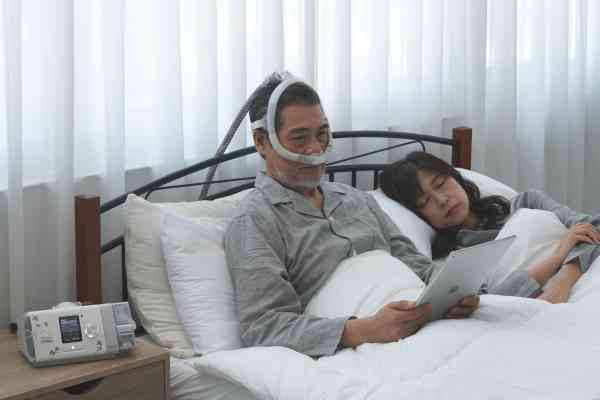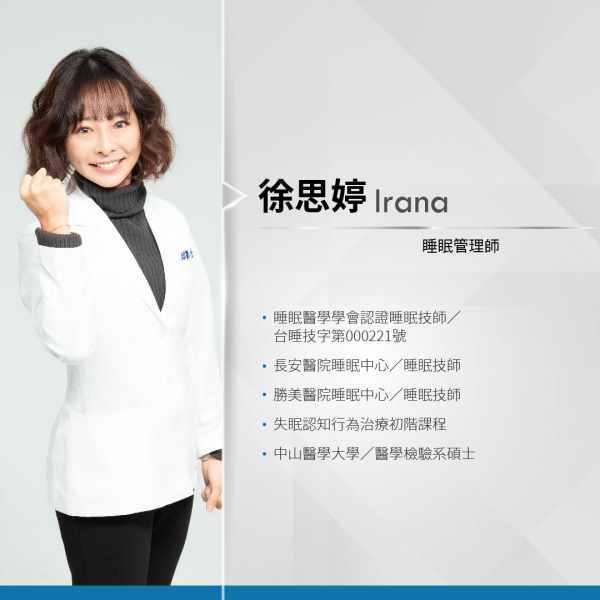無法適應呼吸器的原因及解決方法
撰文:睡眠技師 徐思婷
正壓呼吸器(Continuous positive airway pressure,簡稱:CPAP,亦稱陽壓呼吸器) 是許多睡眠呼吸中止症患者所選擇的治療方式,不僅可改善白天嗜睡狀況、減少夜間頻尿,甚至早晨頭痛的狀況也日益減少。但仍有少部分患者在初期配戴後,可能碰到一些問題或困擾,包含:不習慣臉上有面罩睡覺、使用後口乾、幽閉恐懼症1、吞氣症…等,以下會探討常見的生理原因,幫助病患更容易適應,並能堅持且長期配戴,達到治療效果。

-
不習慣臉上有面罩睡覺
這是非常正常的生理反應,試想一下,當你必須戴一個異物睡覺,身體會本能的扯下面罩,所以需要給身體一些時間去習慣與適應。建議可以嘗試在就寢前,戴著面罩看書、看電視,熟悉戴著面罩的感覺。如此一來可以提升身體與面罩的適應力。
-
使用後口乾、鼻腔乾燥
正常情形,呼吸道具有潮濕及溫暖吸入空氣的作用。當呼吸道長時間濕度不足,容易累積黏稠的痰液,嚴重時甚至阻塞呼吸道危及生命。適當的濕度可改善呼吸道分泌物的黏稠度,並可提升黏液纖毛清運的功能, 因此使用正壓呼吸器時必須搭配潮濕加熱器,以維持呼吸道內最佳的濕度及溫度2,3。
-
幽閉恐懼症
有少部分的使用者反映,剛戴上面罩時,造成心理極度的不適與焦慮,通常較常發生在全罩式的面罩的使用者,幽閉恐懼症的感覺可能會干擾使用4,5。可以嘗試更換鼻枕式的面罩,因為此款是所有類別面罩中與臉部皮膚接觸面最小,進而可以減少幽閉恐懼的狀況發生6-8。適應的期間可以在睡前試著做一些放鬆的運動,如:冥想、靜坐、伸展運動,對於幽閉恐懼症的情形可以緩解。
-
吞氣症 (脹氣)
使用正壓呼吸器有一個非常常見的副作用-吞氣症。通常是因為加壓的氣體被誤吞入食道,出現排氣、打嗝等胃部不適情形,有些案例甚至併發嚴重的胃食道逆流9。有研究指出,適當的調整正壓呼吸器的壓力(太高或太低)可以減少吞氣症的發生。10,11吞氣症的產生,也有可能與配戴面罩的有關,使用上經常遇到漏氣或口乾,可以嘗試更換他款面罩,降低夜間張口呼吸的情形,進而緩解吞氣症的問題。
在初期配戴的時候,習慣每天使用正壓呼吸器並不是件容易的事情,除了本身需要多點耐心與家人的鼓勵外,使用操作上碰到問題,及時與醫師或睡眠技師討論,能夠有效的提升配戴的舒適性。最後,希望大家都使用呼吸器後,能睡得香睡得美。
1.Aurora, R.N., et al. Practice parameters for the surgical modifications of the upper airway for obstructive sleep apnea in adults. Sleep 33, 1408-1413 (2010).
2.Koutsourelakis, I., et al. Nasal inflammation in sleep apnoea patients using CPAP and effect of heated humidification. The European respiratory journal 37, 587-594 (2011).
3.Li, H.Y., et al. Acoustic reflection for nasal airway measurement in patients with obstructive sleep apnea-hypopnea syndrome. Sleep 28, 1554-1559 (2005).
4. Kribbs, N.B., et al. Objective measurement of patterns of nasal CPAP use by patients with obstructive sleep apnea. The American review of respiratory disease 147, 887-895 (1993).
5. Chasens, E.R., Pack, A.I., Maislin, G., Dinges, D.F. & Weaver, T.E. Claustrophobia and adherence to CPAP treatment. Western journal of nursing research 27, 307-321 (2005).
6. Massie, C.A. & Hart, R.W. Clinical outcomes related to interface type in patients with obstructive sleep apnea/hypopnea syndrome who are using continuous positive airway pressure. Chest 123, 1112-1118 (2003).
7.Lanza, A., et al. Continuous positive airway pressure treatment with nasal pillows in obstructive sleep apnea: long-term effectiveness and adherence. Sleep medicine 41, 94-99 (2018).
8.Ryan, S., Garvey, J.F., Swan, V., Behan, R. & McNicholas, W.T. Nasal pillows as an alternative interface in patients with obstructive sleep apnoea syndrome initiating continuous positive airway pressure therapy. Journal of sleep research 20, 367-373 (2011).
9.Shepherd, K., Hillman, D. & Eastwood, P. Symptoms of aerophagia are common in patients on continuous positive airway pressure therapy and are related to the presence of nighttime gastroesophageal reflux. Journal of clinical sleep medicine : JCSM : official publication of the American Academy of Sleep Medicine 9, 13-17 (2013).
10.Ruben, H., Knudsen, E.J. & Carugati, G. Gastric inflation in relation to airway pressure. Acta anaesthesiologica Scandinavica 5, 107-114 (1961).
11.Holloway, R.H., Hongo, M., Berger, K. & McCallum, R.W. Gastric distention: a mechanism for postprandial gastroesophageal reflux. Gastroenterology 89, 779-784 (1985).
作者簡介:睡眠技師 徐思婷

撰文:睡眠技師 徐思婷
正壓呼吸器(Continuous positive airway pressure,簡稱:CPAP,亦稱陽壓呼吸器) 是許多睡眠呼吸中止症患者所選擇的治療方式,不僅可改善白天嗜睡狀況、減少夜間頻尿,甚至早晨頭痛的狀況也日益減少。但仍有少部分患者在初期配戴後,可能碰到一些問題或困擾,包含:不習慣臉上有面罩睡覺、使用後口乾、幽閉恐懼症1、吞氣症…等,以下會探討常見的生理原因,幫助病患更容易適應,並能堅持且長期配戴,達到治療效果。

-
不習慣臉上有面罩睡覺
這是非常正常的生理反應,試想一下,當你必須戴一個異物睡覺,身體會本能的扯下面罩,所以需要給身體一些時間去習慣與適應。建議可以嘗試在就寢前,戴著面罩看書、看電視,熟悉戴著面罩的感覺。如此一來可以提升身體與面罩的適應力。
-
使用後口乾、鼻腔乾燥
正常情形,呼吸道具有潮濕及溫暖吸入空氣的作用。當呼吸道長時間濕度不足,容易累積黏稠的痰液,嚴重時甚至阻塞呼吸道危及生命。適當的濕度可改善呼吸道分泌物的黏稠度,並可提升黏液纖毛清運的功能, 因此使用正壓呼吸器時必須搭配潮濕加熱器,以維持呼吸道內最佳的濕度及溫度2,3。
-
幽閉恐懼症
有少部分的使用者反映,剛戴上面罩時,造成心理極度的不適與焦慮,通常較常發生在全罩式的面罩的使用者,幽閉恐懼症的感覺可能會干擾使用4,5。可以嘗試更換鼻枕式的面罩,因為此款是所有類別面罩中與臉部皮膚接觸面最小,進而可以減少幽閉恐懼的狀況發生6-8。適應的期間可以在睡前試著做一些放鬆的運動,如:冥想、靜坐、伸展運動,對於幽閉恐懼症的情形可以緩解。
-
吞氣症 (脹氣)
使用正壓呼吸器有一個非常常見的副作用-吞氣症。通常是因為加壓的氣體被誤吞入食道,出現排氣、打嗝等胃部不適情形,有些案例甚至併發嚴重的胃食道逆流9。有研究指出,適當的調整正壓呼吸器的壓力(太高或太低)可以減少吞氣症的發生。10,11吞氣症的產生,也有可能與配戴面罩的有關,使用上經常遇到漏氣或口乾,可以嘗試更換他款面罩,降低夜間張口呼吸的情形,進而緩解吞氣症的問題。
在初期配戴的時候,習慣每天使用正壓呼吸器並不是件容易的事情,除了本身需要多點耐心與家人的鼓勵外,使用操作上碰到問題,及時與醫師或睡眠技師討論,能夠有效的提升配戴的舒適性。最後,希望大家都使用呼吸器後,能睡得香睡得美。
1.Aurora, R.N., et al. Practice parameters for the surgical modifications of the upper airway for obstructive sleep apnea in adults. Sleep 33, 1408-1413 (2010).
2.Koutsourelakis, I., et al. Nasal inflammation in sleep apnoea patients using CPAP and effect of heated humidification. The European respiratory journal 37, 587-594 (2011).
3.Li, H.Y., et al. Acoustic reflection for nasal airway measurement in patients with obstructive sleep apnea-hypopnea syndrome. Sleep 28, 1554-1559 (2005).
4. Kribbs, N.B., et al. Objective measurement of patterns of nasal CPAP use by patients with obstructive sleep apnea. The American review of respiratory disease 147, 887-895 (1993).
5. Chasens, E.R., Pack, A.I., Maislin, G., Dinges, D.F. & Weaver, T.E. Claustrophobia and adherence to CPAP treatment. Western journal of nursing research 27, 307-321 (2005).
6. Massie, C.A. & Hart, R.W. Clinical outcomes related to interface type in patients with obstructive sleep apnea/hypopnea syndrome who are using continuous positive airway pressure. Chest 123, 1112-1118 (2003).
7.Lanza, A., et al. Continuous positive airway pressure treatment with nasal pillows in obstructive sleep apnea: long-term effectiveness and adherence. Sleep medicine 41, 94-99 (2018).
8.Ryan, S., Garvey, J.F., Swan, V., Behan, R. & McNicholas, W.T. Nasal pillows as an alternative interface in patients with obstructive sleep apnoea syndrome initiating continuous positive airway pressure therapy. Journal of sleep research 20, 367-373 (2011).
9.Shepherd, K., Hillman, D. & Eastwood, P. Symptoms of aerophagia are common in patients on continuous positive airway pressure therapy and are related to the presence of nighttime gastroesophageal reflux. Journal of clinical sleep medicine : JCSM : official publication of the American Academy of Sleep Medicine 9, 13-17 (2013).
10.Ruben, H., Knudsen, E.J. & Carugati, G. Gastric inflation in relation to airway pressure. Acta anaesthesiologica Scandinavica 5, 107-114 (1961).
11.Holloway, R.H., Hongo, M., Berger, K. & McCallum, R.W. Gastric distention: a mechanism for postprandial gastroesophageal reflux. Gastroenterology 89, 779-784 (1985).
作者簡介:睡眠技師 徐思婷

-
【完整解析】睡眠呼吸中止症10大常見問題一次搞懂Jun 28, 2023
-
科林睡得美睡眠技師助你一夜好眠May 19, 2022
-
半夜打呼驚醒枕邊人 小心睡眠呼吸中止症找上門!Jun 10, 2022
-
2024全台睡眠檢查地點查詢Jan 02, 2024
-
睡眠測試ing 在家也能DIY!Aug 25, 2021
